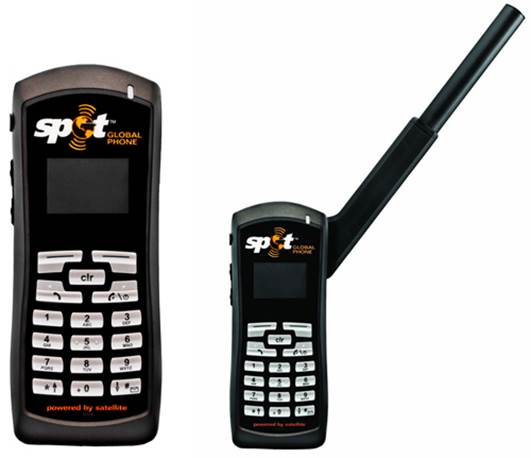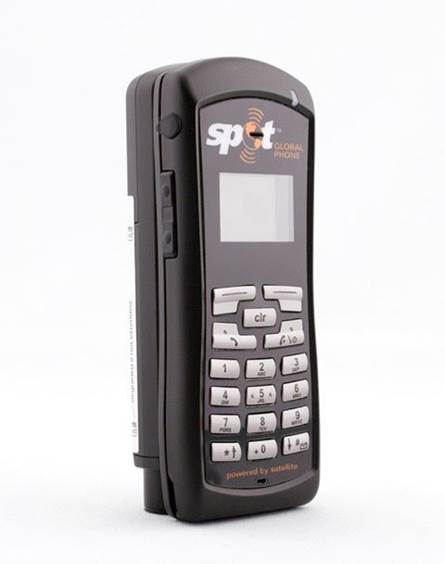At last, there is a mobile phone that will
come out in 2013, which is satisfied by Zack Morris.
Let’s forget all the jokes, Global Phone of
Spot is definitely not the thinnest mobile phone on the planet, but it can
receive the signals even in the places that your iPhones have to say goodbye.
Spot, in fact, is the sub-company of its giant mother company, Globalstar, who
is no stranger to providing satellite-based service to Argonauts the world
over. Global Phone is one of the early commercial phones of the company,
wiping out all the mysteries about this interesting sat phone – you know, a
kind of mobile devices that is only used by the groups of James Bond’s enemies.

The
Spot Global Phone
The ideal market for this phone is very
obvious: if you are a person who passions in hiking through long routes, an
adventurer, a boater or an explorer, you will probably got to the places that
the phone carriers do not cover. In the real life, it is so easy to find such a
place like that – you just need to enter one of the national parks nearby and
walk along the marked trail for a while. With $499 for the device and month-to-month
plans starting at $25, it is actually an acceptable expenditure for your
“weapon locker”. (Have you ever seen the prices of the subzero sleeping bag
these days?)
However, is it a necessary device for you?
I just tried to find the answer for that question by walking 1,600 miles across
the most desolate territory in the US Southwest and I will tell you everything
in a bit.
Hardware
Let me make this straight: sat phones have
never been attractive. But in reality, Global Phone is more impressive than
those that have been established before it. It has the size of 5.3x2.2x1.5
inch, weight 7.1 ounce and can withstand almost every temperature that the user
can. The token extendable antenna is here in full force, and when fully erect,
the length of the phone nearly triples. The device itself is not a heavy
object; in fact, it's easy to misplace in larger packs. The simple 4-lines
screen gives out every information that you may need – recall that this device
is meant to be used when you need to talk to someone in any emergency
situations. This is not the phone that you usually use to talk to your friends
in your free time.
The buttons are quite tough, and besides
that, there are not much things to talk about its hardware. In my own test, the
device seems to be tough, however, I really concern about the outside case of
the phone (mainly made from plastic) if I drop it from a very high distance. At
the back, there is a shelf for battery; the battery can last for 4-hours of
talking and up to 36-hours on standby. During my week in the wilderness, I
actually squeezed out closer to 50 hours on standby, but obviously, those
heading into the wild won't want to play on their own risks.

Global
Phone is more impressive than those that have been established before it.
Speaking of that, there are only two ways
to recharge this phone: an optional car kit, and the included AC adapter - one
of those inline brick contraptions. Personally, this is the hardest part of the
equation. Why did they design a quite small sat phone without also designing a
slim charger? In my personal view, I rate this phone in this way: 36-hours
battery life is a good point, but if I am planning on going on a 2-weeks trip,
it is far better if I can recharge the phone using the USB cable, or by using a
tidy charger. I recognize that many others who buy this phone also bring along
the solar batteries with them, but seriously speaking, the charger takes a lot
of space in one's pack as the phone. That's just inconvenient.
What’s it like to use a satellite phone?
Spot (and Globalstar) has been through a
long process to make the calling experience as much normal as possible. Each
Global Phone consists of a standard American phone number, but any out-coming
call will be displayed as “unknown” on the receiving device. Apparently, this
is an unfortunate byproduct, as the users today are more likely to ignore any incoming calls that are
not from their contact lists. I highly recommend that you should tell your
friends beforehand; if they are waiting for your emergency call under the name
“unknown”, you then might be saved.

You
just need to open up your phone, rotate the antenna then pull it out
Dialing out is an easy process. You just
need to open up your phone, rotate the antenna then pull it out - trying to
latch onto a signal without it fully extended will lead to plenty of tears...
particularly if you're being chased by some sort of venomous creature. From
there, you can enter the numbers and press call (the buttons are quite hard to
press). The screen will display the signal strength and a message telling you
that your call is processing or not. When finished, the rest is just like what
you normally do on other mobile phones. However, the important thing that you
should be aware of is that you would never be received any incoming call unless
the antenna is not spin and pulled out. On the other words, if you fold the
handset up, you may as well turn it off to conserve battery power.